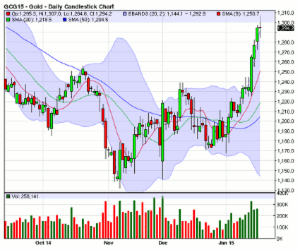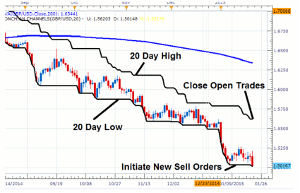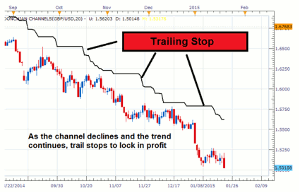Walker England, of DailyFX.com, using a currency pair as an example, highlights a position trading strategy for long-term forex traders using the Hi-Low Breakout for trending markets and demonstrates how using a trail can allow a position to lock in profit with a trend.
There are virtually limitless trading strategies for a variety of trading environments and time constraints. This is good news because whether you have a few minutes or a few hours a week to invest in trading, you can still participate in the forex market.
Find the Daily Trend
The Hi-Low Breakout approach is designed to find entries with the trend when price breaks from a key point of support or resistance. Since we will be selling in a downtrend and buying in an uptrend, the first task of this strategy is to find the trend. To begin, traders will need to identify the primary trend on a Daily chart. A 200 MVA (Simple Moving Average) will be used for this. At this point, traders should note whether price is above or below the MVA.
Below we can see an example of the 200 MVA at work on a GBP/USD Daily chart. The trend is considered to be down because price is below the 200 MVA. Keep this in mind, because if prices were instead above the 200 MVA, the pair would be considered in an uptrend. Once the primary trend is found, keep this information in mind as we move forward and consider market entries.
Identify Support and Resistance
Donchian Channels are a technical tool that can be applied to any chart. Their primary use is to pinpoint current levels of support and resistance by identifying the high and low price on a graph, over a selected number of periods. For today's Hi-Low Breakout strategy, we will be using 20 periods on a daily chart. This means that the channels will be used to identify the current 20-day high and low price. You can see these channels displayed in the graphic below, and this information will be carried over for our entry strategy.
Execution
Now that we have identified both the trend and support and resistance, it is time to plan an entry into the market. In a downtrend (price under the 200 MVA), entry orders to sell the market should be placed one pip under the 20-day low. The idea is, when support is broken in an uptrend traders will look to sell. Conversely, in an uptrend, traders will look to buy the market one pip above the 20-day high. While traders can opt to trade with market orders on a new high or low, entry orders are preferred here. This way orders can be set, and traders can trade breakouts occurring at any time of day without having to be in front of their computer.
Above, we can see a sample sell signal for the GBP/USD. Before today's price action, the GBP/USD had a new 20-day low established at 1.5032. This means a sample entry could be placed at 1.5031. As price passed through this value, the entry would be executed effectively selling the GBP/USD.
Managing Risk and Trailing Stops
Managing your positions is the last, but arguably the most important part of any strategy. When trading the HI-Low Breakout, this process can be simplified through the use of the Donchian Channels already identified on our graph. Remember how our pricing channels (representing the 20-Day high or low) act as an area of support or resistance? In an uptrend, price is expected to move to higher highs and stay above this value. If price moves through the bottom channel, representing a new 20-Day low, traders will want to exit any long positions. Conversely in a downtrend, traders will want to place stops orders at the current 20 period high. This way, traders will exit any short positions upon the creation of a new high.
Finally, traders will use the Donchian Channels as a mechanism to trail their stop forward. As the trend continues, traders will move their stop down the channel. Trailing a stop in this manner will allow you to update the stop with the position and lock in profit as the trend continues. In the event that the trend turns, the positions will be closed at a new high (in a downtrend) or low (in an uptrend).
By Walker England, Trading Instructor, DailyFX.com
























